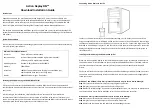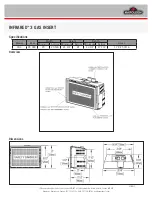
3
5. Operation
Optimum performance and service life are achieved at a temperature
of 20/25°C (68/77°F). The operating temperature range is as follows:
• SBS XL 2V cells: -40°C to +50°C (-40°F to +122°F)
• SBS XL 12V blocs: -40°C to +65°C (-40°F to +149°F).
5.1. Standby / Float Operation
Constant voltage chargers are recommended. The charging voltage should
be set at the equivalent of 2.29Vpc at 20°C (68°F) or 2.275Vpc at 25°C (77°F).
The recommended float voltage temperature compensation is:
• +3mV per cell per °C below 20°C
• –3mV per cell per °C above 20°C
The minimum charging voltage, at any temperature, is 2.21Vpc.
5.2. Charging Current
Due to the very low internal resistance PowerSafe
®
SBS XL batteries will
accept unlimited current during recharge but for cost and practical purposes
in float applications where recharge time to repeat duty is not critical, the
rectifier current can be limited to the load plus 0.1C
10
Amps.
5.3. Discharging
Batteries must not be left in a discharged condition after supplying the load
but must immediately return to recharge mode.
Failure to observe these conditions may result in greatly reduced service life.
Accidental deep discharging
For optimum operation the minimum voltage of the system should be
related to the duty as follows:
In order to protect the battery it is advisable to have system monitoring
and low voltage cut-out.
Deep discharge will produce a premature deterioration of the battery and
a noticeable reduction in the life expectancy of the battery.
Effect of temperature
The temperature has an effect on the battery capacity. With increased
operating temperature the capacity increases; likewise with decreasing
temperature the capacity decreases.
6. Maintenance
In practice, the user usually specifies the maintenance schedule based
on site criticality, location and manpower. However, the following may be
used as a suggested maintenance schedule. Typically, the maintenance
frequency for standard VRLA batteries is scheduled every 6 months.
However, as a result of the increased design life inherent with the SBS XL
range this interval frequency can be extended to deliver additional Total
Cost of Ownership (TCO) benefit, particularly during the early period of
service. As the battery approaches 80% of the intended service it would be
beneficial to increase the frequency of maintenance.
Keep a logbook to record values, power outages, discharge tests, etc.
• Measure the battery string voltage. If necessary, adjust the float voltage
to the correct value.
• Measure individual bloc / cell voltages. After six months of operation,
blocs/cells should be within 5% of the voltage value during float charge,
as specified in chapter 5.1.
• Check the ambient temperature in the immediate environment.
• Inspect for contamination by dust, loose or corroded connections.
If necessary, isolate the string/bloc/cell and clean with a damp soft cloth.
Warning: Do NOT use any type of oil, solvent, detergent, petroleum-based
solvent or ammonia solution to clean the battery containers or lids. These
materials will cause permanent damage to the battery container and lid and
will invalidate the warranty.
State of health monitoring
Typically a load test can be carried out once a year.
Capacity discharge testing is considered as the only true guide to state
of health but can be complimented by the use of Ohmic measurement
trending e.g. Conductance.
• A discharge test should only be carried out on a fully charged battery.
• For a new battery a discharge test should only be carried out after the
commissioning charge is completed as specified in section 2.3.
Ensure the battery is fully recharged before capacity testing and always
complete a full discharge test (partial discharges can lead to false
assessment of state of health).
Best practice is to define the discharge test based on the application
in terms of the load, autonomy or what is practical. The load and end of
discharge voltage should be based on published performance literature.
Depending on the operating temperature a compensation correction
factor may be required.
Log individual bloc/cell voltage throughout the duration of the test
at regular intervals.
Following the capacity test the battery should be fully recharged
in accordance with instructions in section 5.
Ohmic measurements
The correct way to use Ohmic readings is as a trending tool over time to
detect potentially weak or troublesome blocs/cells in a VRLA battery string
in float in service. When the string is first installed and stabilized, a set of
“initial” Ohmic readings should be taken. Since at this time there may still
be some significant variations bloc to bloc/cell to cell in state of charge,
separator acid content, recombination efficiency, etc. it is not unusual
for these initial readings to be typically ± 50% of the mean. If some blocs/
cells exceed this, it would be judicious to equalize charge the string and
do a capacity test.
After the string has been in service for about 6 months, the previous
mentioned variations tend to normalise. At this point another set of Ohmic
readings should be taken and used as the “baseline” readings. At this point,
the blocs/cells should be typically within ± 30% of the average.
These individual “baseline” readings will serve as a reference for trending
purposes for comparison to readings taken later in the battery’s life.
On a yearly basis, Ohmic readings should be taken, recorded and compared
to the baseline readings. If a bloc/cell or battery Ohmic reading varies more
than 50% from the baseline value, the battery should be further evaluated
to determine the cause. A performance or capacity test should be part of
this evaluation.
7. Disposal
PowerSafe SBS XL batteries are recyclable. Scrap batteries must be
packaged and transported in accordance with prevailing transportation
rules and regulations.
Scrap batteries must be disposed of in compliance with local and national
laws by a licensed or certified lead acid battery recycler.
Duty
Minimum end voltage
5 min ≤ t ≤ 1h
1.65V
1h ≤ t ≤ 5h
1.70V
5h ≤ t ≤ 8h
1.75V
8h ≤ t ≤ 20h
1.80V






















